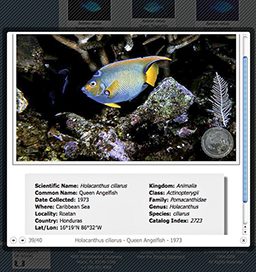
When you first visit the Digital Atlas of Marine Species and Locations (DAMSL) website, it is entirely possible you will be greeted by an image with blank eyes and the gaping green and red maw of what could easily be mistaken for a sea monster. But it’s not; it is a mantis shrimp (Odontodactylus scyllarus), one of the many images of marine life found on the site.
Started as a joint venture between undersea photographer Myron Wang and John A. Gifford, an associate professor in the Marine Affairs and Policy division at the Rosenstiel School of Marine and Atmospheric Science (RSMAS) of the University of Miami, DAMSL was created as a free educational resource for students and educators as well as divers and anyone else interested in marine life. “I came to the school with the idea of giving the gift of my work to someone,” Wang said. “They [RSMAS] looked at the slides and decided they’d like to have them. Then it was just deciding what to do with them.”
In 2007, Gifford and Wang began the exhaustive task of putting all 5,000 of those images online. The DAMSL site contains images as well as information on the marine life depicted in the photographs on the page. Details include the organism’s scientific name, common name, kingdom, class, family, genus and species, photograph date, country and other geographic data.
Before the site was launched, high school students and teachers were invited to test it. Students who used the program found the pictures a new and exciting way to learn about marine life, a marked improvement over their standard textbooks.
What sets DAMSL apart is its comprehensive inclusion of all marine species, including fish; marine invertebrates such as octopuses and anemones; vertebrates other than fish, such as cetaceans; and marine reptiles. There are even images of famous shipwrecks around the world.
Users are able to search for images by geographic location or by type of marine life. An interactive Google Earth feature is also linked to the site; the location of each photograph’s origin is highlighted, allowing the viewer to discover the organisms’ habitats. An adapted version of the site is available for the iPhone.
Updating the site is a never-ending job, but undergraduate marine science students volunteer their time to catalog Wang’s images. The volunteers scan and process the 35mm images, identify the organisms pictured and compile the information on their geographic location.
Eventually, Gifford and Wang hope to offer the images for commercial use to underwrite the upkeep on the database so they can continue to provide it as a free educational resource.
“DAMSL introduces anyone with an interest in the world’s marine life to its beauty,” Gifford said, “and to the basics of classification and taxonomy that marine scientists use in their ongoing research.”
The website can be accessed at www.DAMSL.org.
© Alert Diver — Q2 Spring 2011